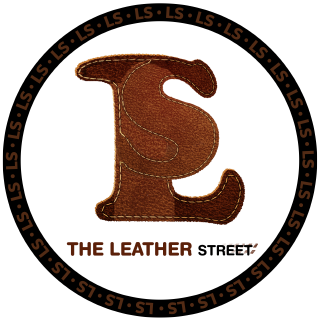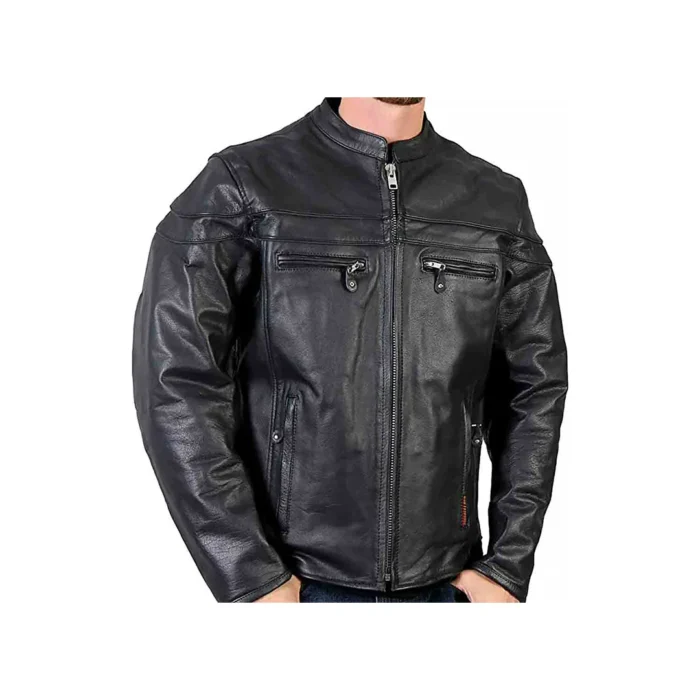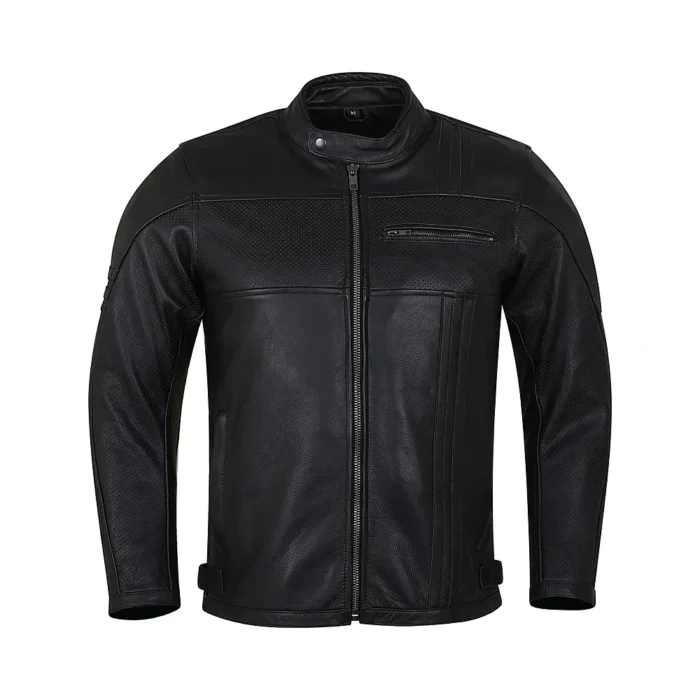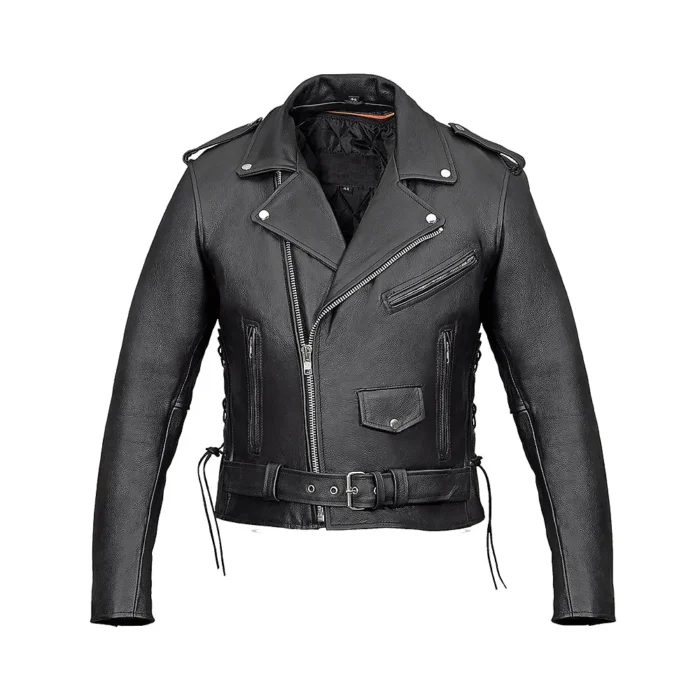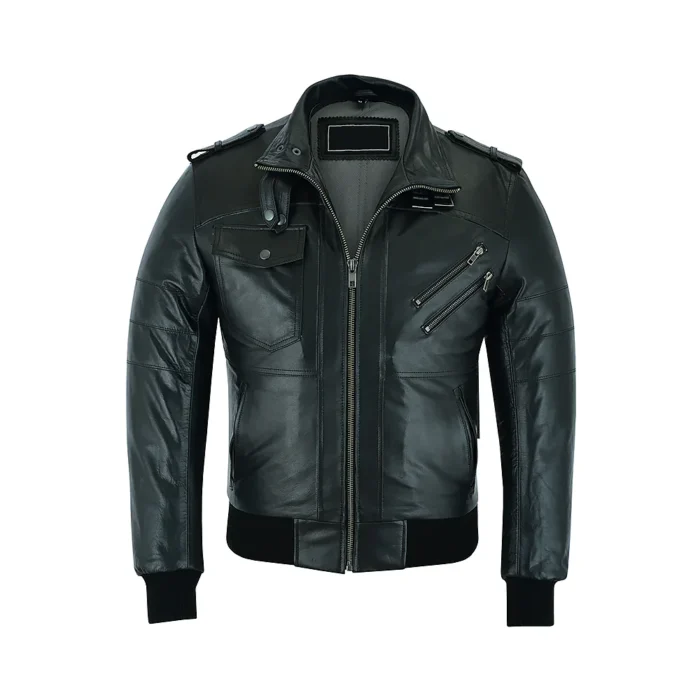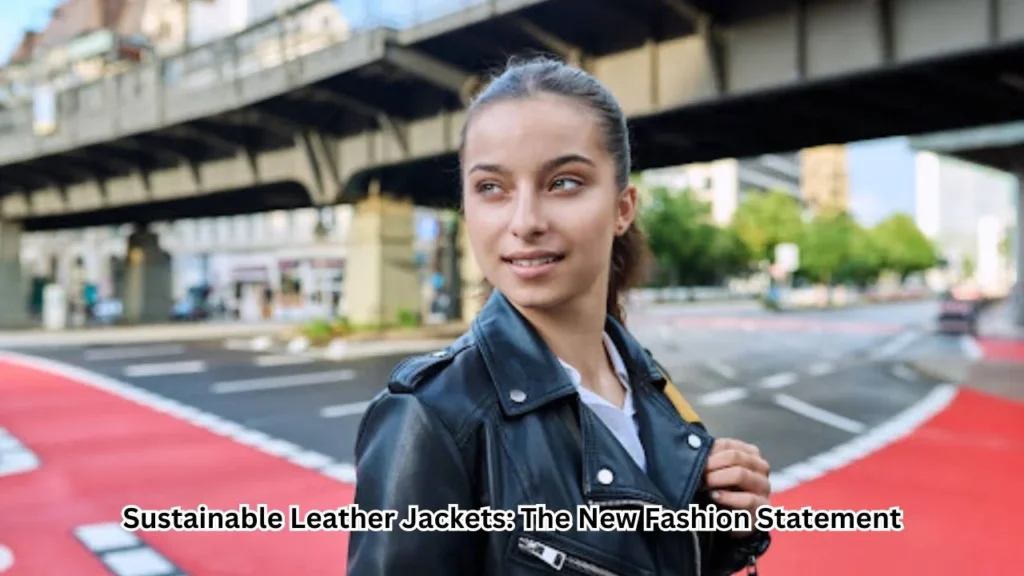
Sustainable Leather Jackets: The New Fashion Statement
The arrival of sustainable leather jackets marks a significant turning point in the history of international fashion toward a more environmentally and morally responsible sector. This change is more than just a fad; rather, it represents the fashion industry’s profound reaction to the urgent problems of social responsibility and environmental destruction. This movement’s core value is its dedication to reimagining luxury and style via the prism of sustainability, providing customers with clothes that are not only aesthetically beautiful but also morally and environmentally responsible.
As we delve into the intricacies of sustainable leather production, the influential role of the USA and California, the burgeoning fashion statement these jackets have become, and the potent impact of consumer demand, we uncover a narrative that transcends traditional fashion paradigms. This story is a testament to the power of innovation, the importance of consumer influence, and the potential for a more sustainable future within the fashion industry.
The Rise of Sustainable Fashion:
The rise of sustainable fashion marks a transformative era in the global fashion industry, signifying a shift towards environmental stewardship, ethical manufacturing practices, and a more conscious consumerism. This movement challenges the traditional paradigms of fashion production and consumption, focusing on minimizing harm to the environment, ensuring fair labor conditions, and creating garments that are designed to last. The growing emphasis on sustainability within the fashion sector reflects a broader cultural awakening to the urgent need for environmental preservation and social responsibility.
Understanding Sustainable Fashion
Sustainable fashion encompasses a wide range of practices and principles aimed at reducing the negative impacts of clothing production on the planet. It involves careful consideration of materials, production processes, and the lifecycle of garments. Sustainable fashion advocates for the use of eco-friendly materials, such as organic cotton, bamboo, recycled textiles, and innovative alternatives like Piñatex (pineapple leather) and mushroom leather. These materials are chosen for their lower environmental footprint, in terms of water usage, chemical treatments, and carbon emissions.
The Environmental Imperative
The traditional fashion industry is one of the world’s largest polluters, responsible for significant water pollution, waste production, and greenhouse gas emissions. The fast fashion model, in particular, has been criticized for its unsustainable practices, including the rapid turnover of low-cost, low-quality garments that contribute to massive waste and exploitation of labor. Sustainable fashion seeks to counteract these issues by promoting slower production schedules, higher quality pieces, and transparency throughout the supply chain, ensuring that environmental and ethical standards are upheld.
Innovations in Sustainable Leather Production:
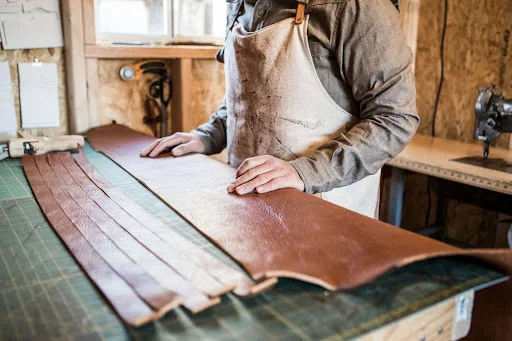
Innovations in sustainable leather production are leather the fashion industry, addressing critical environmental concerns while maintaining the allure and functionality that have made leather a staple material for centuries. As the demand for sustainable fashion grows, both established brands and startups are exploring new ways to produce leather that minimizes its impact on the planet. These innovations span from environmentally friendly tanning processes to the development of entirely new materials that mimic the properties of traditional leather without the ecological footprint.
Vegetable Tanning
One of the oldest methods of leather production, vegetable tanning, has seen a resurgence in popularity due to its environmentally friendly credentials. Unlike conventional chrome tanning, which uses harmful chemicals and produces toxic waste, vegetable tanning utilizes natural tannins found in plant matter such as tree bark, leaves, and fruits. This process not only reduces the use of harmful chemicals but also results in leather with a unique, natural patina that ages beautifully over time.
Recycled and Upcycled Leather
The fashion industry is increasingly turning to recycled and upcycled leather as a way to reduce waste and make use of existing resources. Recycled leather involves repurposing scraps and offcuts from the production process or transforming post-consumer leather goods into new materials. Upcycled leather takes this concept further, creatively reimagining old leather products into new, high-quality items, thus extending their lifecycle and reducing the need for new raw materials.
The Role of USA and California in Sustainable Leather Fashion:
The United States, with California at its forefront, plays a pivotal role in the advancement of sustainable leather fashion, setting trends that resonate globally. The combination of technological innovation, environmental awareness, and a vibrant fashion culture makes the USA, particularly California, a breeding ground for sustainable practices in the leather industry. This leadership is crucial in a time when the fashion world is increasingly scrutinized for its environmental impact and ethical practices.
Innovation and Technology
The USA is home to some of the world’s leading research institutions and tech companies, which contribute significantly to advancements in sustainable leather production. Innovations such as lab-grown leather and plant-based leather alternatives often find their roots in American laboratories, where scientists are working to reduce the ecological footprint of traditional leather. California, known for its tech industry and progressive environmental policies, is particularly instrumental in pioneering these materials. Companies like MycoWorks, which specializes in mycelium-based leather, and Modern Meadow, focusing on biofabrication leather, are examples of how the state is at the cutting edge of sustainable fashion technology.
Environmental Legislation and Policies
California’s strict environmental regulations have a significant impact on the fashion industry’s approach to sustainability. The state’s leadership in setting high standards for environmental protection encourages businesses to adopt greener practices. Legislation such as the California Transparency in Supply Chains Act pushes companies towards greater transparency regarding their manufacturing processes, including leather production. These policies not only affect local businesses but also set a precedent for companies nationwide and globally, fostering a more sustainable approach to fashion.
Sustainable Leather Jackets as a Fashion Statement:
Sustainable leather jackets are transforming the fashion landscape, emerging as a powerful statement of eco-consciousness and ethical responsibility. As the global community becomes increasingly aware of the environmental and ethical implications of their fashion choices, sustainable leather jackets stand at the forefront of a movement that marries style with sustainability. This new fashion statement transcends mere aesthetics, reflecting a deeper commitment to preserving our planet and respecting the beings that inhabit it.
Redefining Luxury and Style
The emergence of sustainable leather jackets as a coveted fashion item redefines notions of luxury and style. Traditionally, luxury was often associated with exclusivity and opulence, sometimes at the expense of environmental integrity and ethical practices. However, the rising popularity of sustainable leather jackets signifies a shift towards a new definition of luxury—one that values innovation, ethical production, and environmental stewardship as much as design and quality. This shift aligns with a broader trend in consumer preferences, where authenticity, transparency, and sustainability are becoming key determinants of luxury.
The Appeal of Sustainable Leather Jackets

The appeal of sustainable leather jackets lies in their unique ability to combine timeless style with modern values. These jackets retain the classic aesthetics and durability that have made leather outerwear a staple in wardrobes worldwide, while also embracing eco-friendly materials and ethical manufacturing processes. Options range from jackets made with vegetable-tanned leather, which uses natural materials instead of harmful chemicals, to those crafted from innovative plant-based leathers derived from sources like pineapple leaves or mushrooms. These materials offer a lower environmental footprint and are often biodegradable, addressing concerns about waste and pollution associated with traditional leather production.
Consumer Influence and the Future of Sustainable Leather Jackets:
Consumer influence plays a critical role in shaping the future of sustainable leather jackets and, by extension, the broader fashion industry. As awareness of environmental issues and ethical concerns grows, consumers are increasingly seeking out brands that align with their values. This shift in consumer behavior is driving demand for sustainable practices, compelling the fashion industry to adapt and innovate. The future of sustainable leather jackets, therefore, is inextricably linked to the evolving preferences and actions of consumers.
The Power of Consumer Demand
Today’s consumers are more informed and conscientious than ever before. Armed with knowledge about the environmental impact of the fashion industry and the ethical implications of their purchases, many are choosing to support brands that prioritize sustainability. This demand for eco-friendly and ethically produced garments is pushing brands to explore sustainable alternatives to traditional leather, such as plant-based materials and recycled leathers. As consumers continue to vote with their wallets, the market for sustainable leather jackets is expected to grow, encouraging more brands to adopt sustainable practices.
The Role of Social Media and Influencers
Social media platforms and influencers play a significant role in shaping consumer perceptions and driving the sustainability agenda. Influencers who advocate for eco-conscious fashion can sway their followers to consider the environmental and ethical dimensions of their fashion choices. Through social media, consumers are also able to share information, discuss brands’ practices, and hold companies accountable, creating a more transparent and engaged fashion ecosystem. This dynamic interaction between consumers, influencers, and brands accelerates the adoption of sustainable practices and amplifies the demand for sustainable leather jackets.
Challenges and Opportunities:
The journey toward sustainable leather jackets encapsulates a complex interplay of challenges and opportunities. As the fashion industry seeks to reconcile its traditional practices with the urgent need for sustainability, it navigates a landscape filled with both obstacles and potential for groundbreaking innovation. Understanding these dynamics is crucial for fostering a more sustainable fashion ecosystem.
Challenges
1. Cost Implications: One of the primary challenges in producing sustainable leather jackets is the higher cost associated with eco-friendly materials and ethical manufacturing processes. Sustainable practices, such as using vegetable-tanned leather or investing in innovative materials like lab-grown leather, often come with a premium. This cost barrier can make sustainable leather jackets less accessible to a broad consumer base, potentially limiting their market penetration.
2. Scaling Sustainable Practices: Scaling sustainable leather production to meet global demand poses significant challenges. Many sustainable practices are currently niche and may not be immediately capable of supporting the volume required by the mainstream market. Additionally, the infrastructure for recycling or upcycling leather is not as developed as for other materials, posing logistical challenges in creating a circular economy for leather goods.
3. Consumer Awareness and Education: Despite growing interest in sustainability, there remains a gap in consumer awareness and understanding of the complexities of sustainable leather production. Misconceptions about the environmental impact of alternative materials and a lack of transparency in the supply chain can hinder informed decision-making among consumers.
Opportunities
1. Innovation in Materials: The challenges of sustainability drive innovation, leading to the development of new materials that offer environmentally friendly alternatives to traditional leather. Innovations such as plant-based leathers and lab-grown options not only reduce the environmental footprint of leather production but also open new avenues for design and creativity.
2. Increased Consumer Demand: The growing consumer demand for sustainable products presents a significant opportunity for brands to lead the way in sustainable leather fashion. As awareness and concern for environmental issues increase, consumers are more willing to invest in products that align with their values, creating a market for sustainable leather jackets and driving industry-wide change.
3. Collaboration and Industry Standards: The challenges of sustainability are too vast for any single entity to tackle alone. Collaborations between brands, manufacturers, innovators, and even competitors can lead to shared solutions and advancements in sustainable practices. Additionally, the development of industry-wide standards and certifications for sustainable leather can provide clear guidelines and encourage adoption across the fashion industry.
4. Brand Differentiation and Loyalty: Embracing sustainability offers brands an opportunity to differentiate themselves in a crowded market. By committing to sustainable leather production, brands can build trust and loyalty with consumers who prioritize environmental and ethical considerations in their purchasing decisions.
Conclusion
The journey towards sustainable leather jackets encapsulates a dynamic interplay of innovation, challenges, and opportunities that herald a new era for the fashion industry. At this juncture, it is evident that the way forward is marked by the combined efforts of fashion designers, customers, and legislators, all of whom are contributing to a vision of fashion that honors sustainability and style. The emergence of environmentally friendly leather substitutes and innovative manufacturing methods, which have contributed to the rise of sustainable fashion, is indicative of a larger cultural movement in favor of aware and responsible consumerism. As this movement continues to gain momentum, the future of fashion looks promisingly green, characterized by garments that tell stories of environmental stewardship, ethical integrity, and enduring style. In embracing sustainable leather jackets, the fashion industry not only makes a bold statement about its values but also invites consumers to be active participants in shaping a more sustainable, just, and beautiful world.
-
$499.99$329.99 -
$559.99$349.99 -
$549.99$329.99 -
$549.99$329.99
